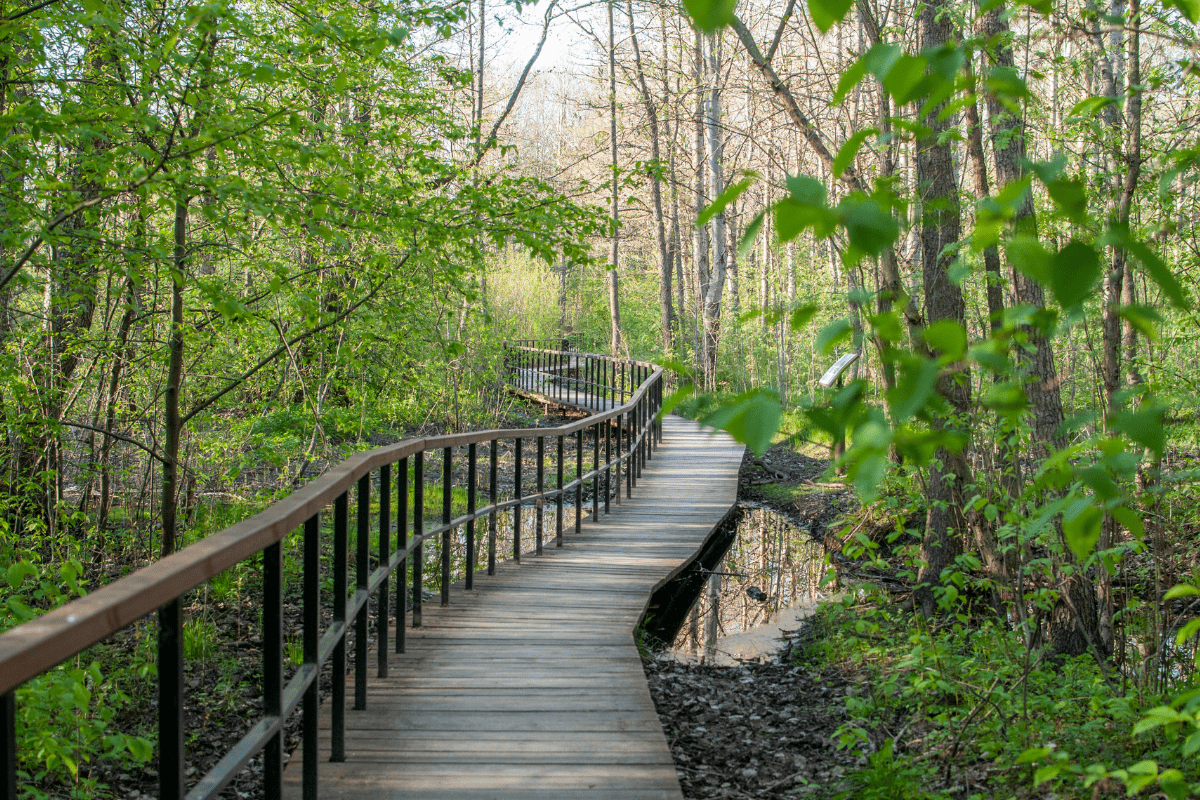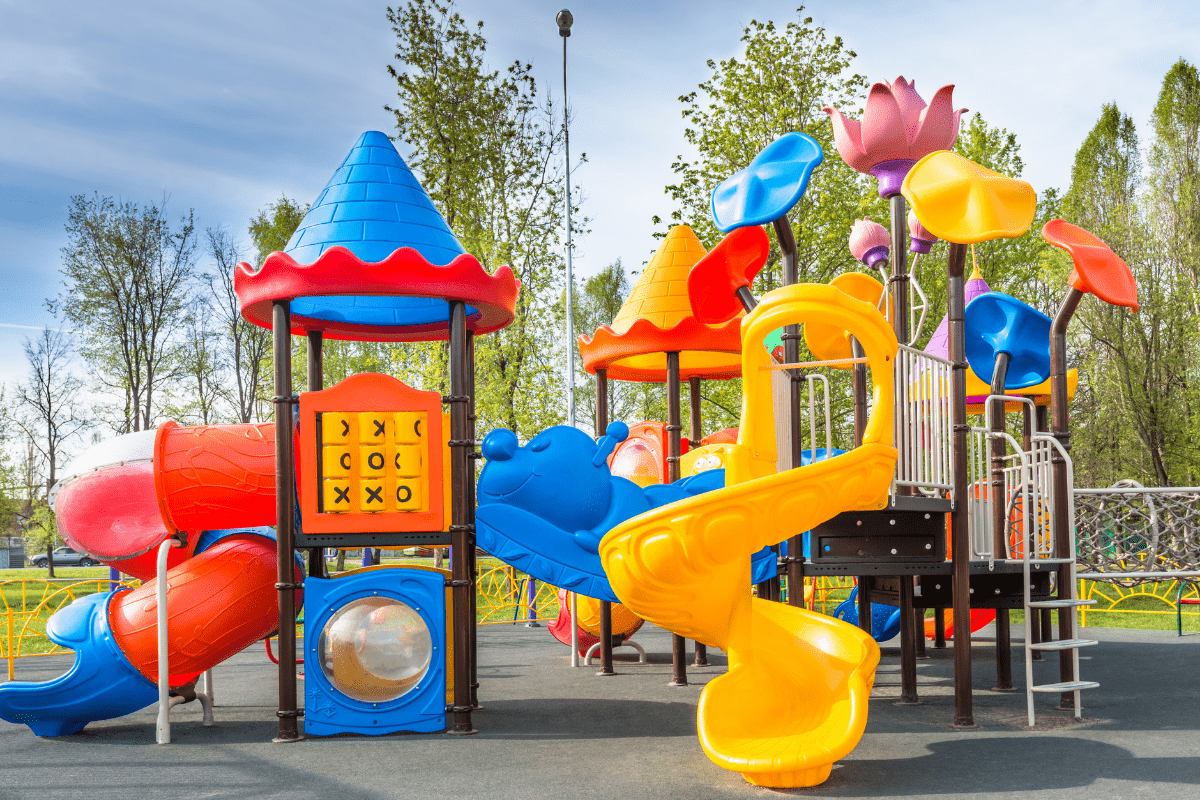Wilmington is a haven for hikers, offering trails that wind through sun-dappled forests, quiet marshes, and lively city parks. Whether you crave serene coastal views or want to spot carnivorous plants, there’s a path nearby for every mood and skill level.
Let’s get to it.
Piney Ridge Nature Preserve
Tucked into the heart of Wilmington, Piney Ridge Nature Preserve presents a classic coastal Carolina landscape with stands of longleaf pine and open sky. The flat trail system spans roughly a hundred acres, featuring smooth asphalt sections and raised boardwalks crossing wet areas. A wheelchair- and stroller-friendly 600-foot loop winds through a carnivorous plant garden where Venus flytraps and pitcher plants thrive in damp soil. Wooden overlooks at pond edges provide resting spots and views of coastal grasses.
Free parking sits at the trailhead, and interpretive signs offer clear information about local flora and its ecological role. Off the main loop, natural dirt trails invite visitors seeking a dustier surface underfoot. The preserve saw recent upgrades to trail surfaces and overlook decks, giving it a fresh appearance. Weekday visits tend to be quiet, while weekends draw a steady but not overwhelming crowd. Carnivorous specimens bloom most vividly from April through June. Restrooms are available near the entrance, and benches appear at intervals for quick breaks.
Smith Creek Park
Smith Creek Park offers a relaxed setting with a spring-fed lake at its center. A 1.3-mile paved loop encircles the water, granting clear views and room for strollers, wheelchairs, and rolling coolers. For shade, a one-mile wooded trail branches off under a canopy of trees. That path has packed dirt and mulch surfaces with gentle contours suitable for casual walkers. Ducks and geese gather near the shore, while kingfishers and herons appear on calm mornings.
Parking sits close to a playground with swings and slides, and picnic shelters with tables and grills come equipped with nearby grills. Drinking fountains and pet waste stations stand along the main loop for added convenience. Dogs on leashes share the paths with families and solo hikers. Restrooms are located by the large shelter. Weekends and evenings bring a steady flow of visitors, but weekday mornings remain quiet. Spring and fall deliver mild temperatures, while summer heat makes the shaded trail a popular alternative.
Stanley Rehder Carnivorous Plant Garden at Piney Ridge Nature Preserve – Wilmington
The Stanley Rehder Carnivorous Plant Garden at Piney Ridge Nature Preserve in Wilmington runs a half-mile wetlands trail lined with pitcher plants, Venus flytraps, and sundews. Visitors start on paved pathways that lead to a wooden overlook equipped with benches. Interpretive panels along the route describe each plant species and its unique trapping mechanism.
Further inside, the trail shifts to cobblestones and dirt, which can become muddy after rain. Visitors are advised to wear sturdy footwear when exploring this section. Yellow and crimson pitcher plants bloom in March and April. Venus flytraps open in late spring while sundews remain visible into August. A small gravel parking lot sits adjacent to the trailhead, and the garden sees steady but manageable foot traffic. This specialized area draws botanists and casual enthusiasts alike, offering a concise but immersive look at North Carolina’s carnivorous flora.
Halyburton Park
Halyburton Park in Wilmington spans 58 acres of mixed habitats with more than a mile of accessible trails. The main loop extends a little over one mile on paved and sandy surfaces. Benches appear at regular intervals, offering spots for rest or wildlife observation. Sandhill hills rise gently alongside ponds and groves of pine and hardwood, while wildflower patches color the understory during spring and summer.
A historic Civil War battle mound sits off the main trail, marked by a sign that explains its past. Picnic tables and restrooms lie near the park entrance, and a drinking fountain welcomes dogs on leashes. Interpretive panels describe local plants and bird species, adding an educational dimension. The park’s generous trail width keeps traffic flowing, so hikers, families, and wheelchair users can share the space without crowding. Even on busy afternoons the setting remains open and serene.
Long Leaf Park
Visitors to Long Leaf Park enjoy a versatile neighborhood green space under a canopy of tall longleaf pines. Three accessible loop options range from a one-mile nature trail with packed earth to a 1.5-mile intermediate route and a 2.6-mile main loop on paved or firm surfaces. Signage appears at every junction, and benches stand ready for brief rests, making it easy for strollers, wheelchairs, and casual walkers to stay on course.
A duck pond near the main walkway attracts turtles, waterfowl, and seasonal blooms of azaleas and camellias. The park offers a splash pad for children, lighted sports courts, and a fenced dog area where pets on leashes can roam. Playgrounds with inclusive equipment accommodate all ages, and picnic shelters with tables dot the grounds. Ample parking surrounds the central plaza, and a decorative gazebo provides a focal point. Visitors often fill the picnic spots during afternoon hours, so arriving early can secure the best location.
Wade Park
Despite its compact size, Wade Park offers a surprising variety of features on its 17 acres. The paved loop covers just over half a mile and stays mostly level, with only about six feet of elevation change. A boardwalk section carries the path across the marsh, giving a closer look at wetland plants.
Wildlife sightings are common. Turtles lounge near the water’s edge and red-winged blackbirds flit among the reeds. Informational signs along the trail explain wetland habitats and highlight local species. The loop surface is smooth asphalt, which makes it easy to navigate with a stroller or wheelchair.
Parking space is limited to about a dozen spots, but the restrooms stand right next to the lot. A covered picnic shelter sits nearby for small gatherings. A playground draws families, while runners and birdwatchers find enough room to pass without clashing crowds.
Leashed dogs are welcome, and trail access connects to the Gary Shell trail system for those seeking longer excursions. Wade Park balances quiet natural areas with reliable amenities.
Greenfield Park
Set within 250 acres of trees and grass, Greenfield Park feels more like an oasis than a city park. The paved loop trail stretches 4.8 miles across mostly flat ground and suits walkers, joggers, wheelchairs, and strollers. An accessible fishing dock juts into the lake, so anglers can fish without slogging through mud.
Free parking and restrooms are located near trailheads and playgrounds. Boat and kayak rentals sit at the water’s edge. Picnic shelters and benches appear under mature oaks for shaded breaks.
Wildlife viewing is a highlight. Herons wade along the shoreline, turtles rest on logs, and alligators have been spotted near deeper stretches. Dogs on leash are welcome. Clear signage guides visitors around the lake.
The park fills up on warm weekends, but the wide trail handles crowd flow well. City crews plan to resurface sections of the loop by summer 2024 and carry out lake-edge repairs to control algae. Spring and fall bring mild weather and prime birdwatching conditions. Greenfield Park blends ease of access with varied activities for visitors year-round.
Ogden Park
This neighborhood park in New Hanover County offers just about everything you might expect. The paved walking trail is a smooth, flat one-mile loop around a small pond. Watch for resident ducks and geese who treat the area as their personal domain. Benches dot the path every few hundred feet, and shady spots provide relief on sunny days.
The layout is straightforward. On one side you will pass athletic fields where games often draw spectators. The wide path accommodates strollers and wheelchairs without issue. An outdoor gym area along the trail lets you try a few pull-ups or squats before heading to a sheltered picnic table.
Dogs are welcome in the fenced dog park, and the entire park is pet-friendly. Restrooms are clean and scattered near key points. Free parking and grills make it easy to plan a gathering. Ogden Park stays busy during after-work strolls and lively weekend visits. Still, its tidy grounds and well-maintained features hold up well year-round.
Pages Creek Park Preserve
Pages Creek Park Preserve keeps its focus on tidal creek views and simple paths. The main feature is a one-mile loop trail made of dirt and gravel. Roots and muddy spots can appear after rain, so strollers will rattle and wheelchairs may struggle. The loop remains easy on foot, but sturdy shoes are recommended.
Interpretive signs along the trail offer tidbits on the marsh ecosystem. Benches provide rest stops with sweeping views of salty marshland and creek channels. A kayak launch sits at one edge of the loop for paddlers ready to explore the tidal waters.
Parking is limited to about ten spaces in a small gravel lot. Dogs on leash are welcome, and dog-waste bag dispensers stand near the trailhead. There are no restrooms, so plan accordingly. Weekday mornings tend to be quiet, while fall delivers peak birdwatching as migratory species stop at the creek.
Overall, Pages Creek Park Preserve offers straightforward outdoor access with coastal scenery and minimal crowds.
Abbey Nature Preserve
At Abbey Nature Preserve, a 1.3-mile out-and-back trail winds through mixed hardwood and pine forest. The path uses dirt and gravel, with occasional wooden bridges that cross small streams. The total elevation gain stays under 40 feet, making the route easy on the legs.
A 10-acre pond sits about halfway along the trail, complete with an overlook deck and a pier. Turtles often bask on logs, and deer or brightly colored birds may appear at dawn or dusk. Benches placed at regular intervals invite brief rests. Informational signs help identify plants and wildlife.
The preserve offers some accessibility. A handicap-friendly overlook deck and stroller-friendly trail sections provide easier access, though unpaved or uneven patches remain. Free parking is available in a gravel lot, and portable restrooms stand nearby. Trails are well-marked, but fallen limbs can appear after storms.
Off-leash dogs are allowed in designated areas; please bring waste bags. Weekends and school breaks bring the busiest times. Summer calls for bug spray, while spring and fall showcase the best weather and wildflower displays.
Wallace Park
In Wilmington, Wallace Park spans 13 acres of green space in a residential neighborhood. Playground structures, picnic tables under mature trees, and two basketball courts host regular pickup games. A simple network of dirt and gravel trails loops through the park. These paths are entirely flat, so no hiking records are set here, but dogs on leashes can walk alongside everyone else. There are no paved paths or restrooms, and parking is limited to street spaces.
One of the park’s highlights is the small creek winding through its center, crossed by several wooden bridges. Scattered cypress trees add a touch of old growth, and visitors often spot turtles basking on logs or local birds perched overhead. The playground includes an accessible ramp, yet uneven trails make stroller and wheelchair access challenging. Maintenance keeps things basic, so you may see occasional litter or tall grass patches. The atmosphere remains quiet and local during daytime visits. After dark, lighting is minimal, so most guests arrive before sunset.
Bluethenthal Wildflower Preserve
On the UNCW campus, Bluethenthal Wildflower Preserve occupies 10 acres beside academic buildings. A 0.7-mile dirt trail loops around the site, with side paths forming an overall one-mile network. All trails stay flat except for minor bumps over exposed roots. Wheelchairs and strollers may find the unpaved surface tricky, but benches at intervals offer rest stops. Metered parking lines the entrance road, and a free visitor lot sits a short walk away.
Educational signs along the paths describe native plants and wildlife in clear language. Raised beds showcase pitcher plants and Venus Flytraps. Near a small pond, you’ll find an outdoor classroom and a modest amphitheater. Dogs on leashes are welcome. Most days draw only a handful of visitors—birdwatchers or those seeking a gentle stroll. Staff keep the grounds neat without removing every wildflower, preserving a natural feel. Spring and summer bring colorful blooms, while winter keeps many evergreen species and visiting birds on view.




